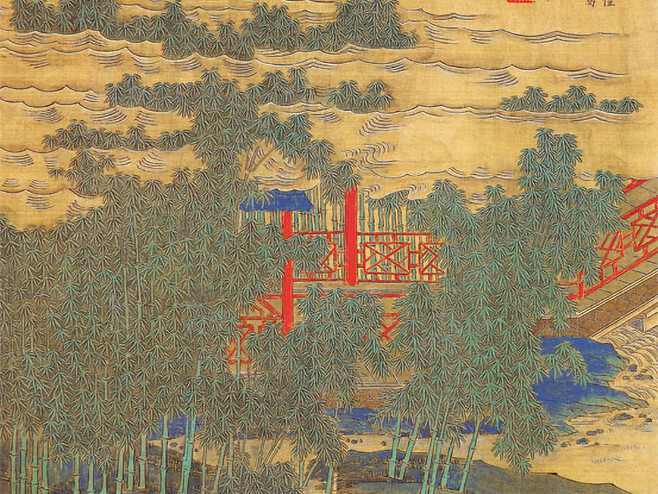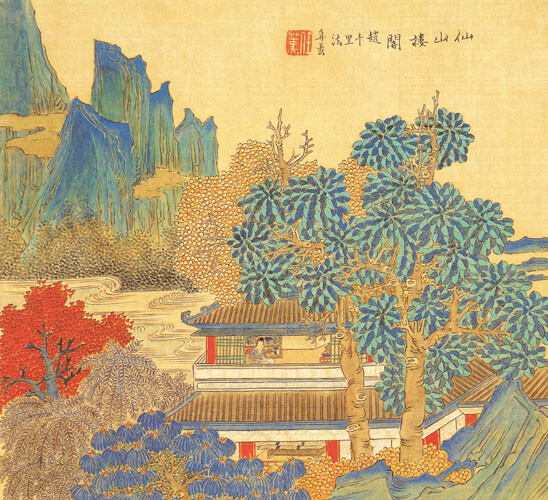Decoration is the excellent gene of Chinese painting, and many of us art workers who lack traditional Chinese cultural accomplishment do not know what this excellent gene is. In order to effectively solve this problem, make people correctly use the decorative language of Chinese painting to distinguish it from decorative painting, and correctly master and use decorative factors in the creation, it is necessary to give a theoretical clarification of the relationship between decorative painting and decorative painting.

Chinese painting is a painting form with traditional painting system and national characteristics in China, which is highly decorative in itself. However, under the impact of Western culture and aesthetic concept of modern life in the 20th century, decoration has become a common concern and pursuit of the goal, the decorative function of Chinese painting is more and more attention, emphasis and prominence, in the completion of the transformation from traditional to modern form at the same time, Chinese painting
Decorative, planarization, formalization. The artistry, including exaggeration and deformability, is obviously enhanced.
However, while the decoration of Chinese painting greatly enriched and developed the painting language of Chinese painting, due to the neglect of the difference between the decorative language of Chinese painting and decorative painting, the confusion between the decorative language of painting and decorative painting appeared, and the undesirable phenomenon of excessive decoration appeared in the creation of Chinese painting. Therefore, in order to effectively solve this problem, so that people correctly use the decorative language of Chinese painting, in order to distinguish from decorative painting, and in the creation of the correct grasp and use of decorative factors, it is necessary to Chinese painting
The relationship between painting decoration and decorative painting is essentially clarified in the theory.
First, decorative and decorative paintings
Decoration is the beautification and modification of natural objects, the way of idealizing aesthetic objects through various expression techniques, and the means and results of human beings' pursuit of formal beauty on the basis of practicality. It aims at the deep sense of order, rhythm and integration, and embodies the inner demand for beauty of human beings. In the history of Chinese painting, Mr. Pang Xunli believes that; "Decoration began with painted pottery in the Neolithic Age, and there was decorative art at least before the 17th century BC. It not only contains people's understanding of real life, but more importantly, it is an important expression and reflection of the spiritual life of human beings seeking beauty. The concrete expression of this kind of beautification and decoration in art is decorative painting. Compared with and different from realistic painting of "scientific representation", decorative painting is an independent art category with decorative or decorative style, which exists to decorate some objects or beautify the environment. "Ci Hai" explains it as: "Broadly refers to paintings that belong to the decoration of objects." Narrow means decorative murals, commercial art in the advertising picture. Decorative painting focuses on the decorative form of expression, and the general realistic painting is different. "That is, when the picture has decorative composition, decorative image, decorative colors and decorative forms of expression at the same time, and is subordinate to the environment and handicraft production, we call it decorative painting." "Decoration as a fundamental artistic activity based on a formal impulse, It is characterized by its formal beauty that is abstract and regular based on the principles of form such as symmetry, balance and rhythm. Decorative paintings represent the world with creative imagination, which is the result of the artist's free thinking choice. Decorative painting has certain craftsmanship, and its creation is sometimes restricted by decorative objects and various specific conditions. It is always based on different decorative requirements to choose the appropriate composition, shape, color and other performance techniques, with the production conditions to decorate a certain environment, highlight a theme. Decorative painting pursues a kind of "formal personality", which is the product of formal beauty. In the form of expression, decorative painting is not to reproduce intuitive imitation of objects, but to emphasize the principles of formal beauty, emphasize people's subjective imagination, abstraction and construction, and use ellipses, exaggerations, distortions, additions and other techniques to beautify, idealize selection, generalization and expression, pursue the truth of subjective ideals, and guide people to obtain easy and pleasant feelings and rich associations. To achieve specific expressions of subjective emotions and decorative beautification
The effect of life. Therefore, decorative paintings are not used as a means of direct catharsis of inner emotions, usually not
Reflects the heavy social content, but a beautification of nature and the carrier of living environment.

Second, the decoration of Chinese painting
The decoration of Chinese painting is reflected in all aspects of Chinese painting. Such as full and balanced composition, exaggerated and refined modeling, skilled and rhythmical line drawing, clear and bright color and dramatic pattern processing, highly patterned and stylized forms of artistic expression. Specifically, it is mainly reflected in the following aspects: 1. Modeling: Chinese painting shows strong decorative interest in modeling, with special emphasis on formal beauty. In the performance of objects, Chinese painters do not adhere to the natural reality of perspective, anatomical structure and color, do not pursue the "likeness" of objects, but according to the needs of the content, the feelings of the author and the aesthetic principle of "simple to dominate the complex", using decorative patterns. Through the bold choice, the use of emphasis, generalization, induction, ellipsis, exaggeration, deformation, refining, highlighting, finishing, symbol stylization, regularity, rhythm, rhythm, idealization and style method, the regular combination, the description of the object simple, abstract, bright, irregular into regular, chaotic into organized, irregular into stereotyped. Thus creating an artistic image that is taken from nature and higher than nature. In particular, the regularity, order, orderliness, formalization and concretization of Chinese painting pay attention to the stylization of symbols, making it the most decorative in the world painting art, and it is also considered as "decorative painting". 2. Concept: Zhang Yanyuan pointed out: "If the mood is not good, the shape of the empty Chen is similar, the brush force is not Qiu, the empty good color, that is not wonderful." Therefore, Chinese painting pays attention to artistic conception and wins with "lively spirit". In Chinese painting, the image is shown in a decorative appearance, emphasizing the "similarity and non-similarity". The image of Chinese painting is the harmonious unity of the subjective will and the natural image, which selects and extracts the desirable components from the image, and is a high-level image that gives play to the creative imagination and synthesizes it. The aesthetic value of Chinese painting lies in the expression of feelings, artistic conception or subjective feelings. At the same time, the image shaping of Chinese painting pursues the two-dimensional space of the plane, rather than the three-dimensional space of the image, and many images are expressed in the form of symbols similar to patterns, which also helps to express the charm and sentiment of the image. In particular, Chinese painting uses lines as a modeling method, and through the art form of lines, the complicated natural images are systematically summarized and purified, so that the picture image is highly concise and simple, bright and refreshing, and the decorative taste of Chinese painting is stronger. 3. Composition: Chinese painting uses free scatter perspective to organize the picture. Scatter composition is a way of composition that allows the painter to freely exert the creativity of imagination and realize multi-viewpoints and multi-angles. It can arrange the objects of different time and different space together, avoiding the time and space restrictions of the performance objects. At the same time, it is combined with the simple color clear contour line to maintain the flatness of the picture, produce a sense of flatness, and make the decorative beauty of the picture more prominent. The most remarkable feature of decorative painting is that it maintains the original "flat" form of graphic art. This way of composition enables Chinese painting to have great space freedom and combination range in the performance of the image, enrichis the content and expression of the picture, and can better play a decorative effect. Therefore, some western art historians often divide Chinese painting into the category of decorative painting, Hegel called the Oriental art led by Chinese painting decorative art. 4. Color: The color of Chinese painting pays attention to the decorative meaning of rationalization and simplicity. "Painting is not like color, the predecessor Xiangma nine Fang Gao". The color of Chinese painting is not to express the realistic reproduction of the color of natural objects, nor is it used as a means of the shape of objects, and the color of objects in the picture is not affected and limited by the color of light source, environmental color and its inherent color, nor does it pursue the color change of objects in nature. Instead, we strive to be subjective, advocate "intended true color", and devote ourselves to the artistic conception and mood of the picture according to the feelings of the author, emphasizing the change of the color of the natural image, subjectively induction of color, independent play of the emotional role of color, and create rational emotional color for the picture. Therefore, color in Chinese painting become rational and emotional, the pursuit of decorative subjective expression effect, with a significant decorative interest. To sum up, many factors such as decorative image modeling and decorative color design make decorative meaning
Interest in Chinese painting has a relatively obvious appearance, so that Chinese painting has a strong decorative style and characteristics. Therefore, Mr. Pang Xunli said, "Decorative style is one of the most ingenious means of Oriental art to solve the antagonistic relationship between art and nature."
Third, the decorative and decorative paintings of Chinese painting
There is a great debate in the academic circles about the relationship between the decorative and decorative paintings of Chinese painting. Mr. Zhang Guangyu once pointed out: "A history of painting has never divided too strictly the so-called decorative painting and non-decorative painting, and an art history has also not divided it." However, in all art, it is absolutely possible to analyze the strength of decoration and the obvious or implicit, but it is not possible to strictly distinguish the opposite of decoration and non-decoration. But some people think that decoration is classified within the scope of industrial arts, as if painting and sculpture do not need to study decorative problems, which is wrong." (5) The ambiguity and confusion of this understanding correspondingly bring about a series of problems in artistic creation. Especially in recent years, with the frequent international art exchanges and the acceleration of information dissemination, the traditional art view has been continuously impacted, and a variety of art types, ideas and schools have come into view, which has intensified people's confusion. Although the decorative language of Chinese painting has been inherited, attached importance and applied in the creation, which has greatly enriched the painting language of each kind, at the same time, it is not difficult to see that how to accurately use the decorative language of Chinese painting is still unresolved. It is specifically reflected in the excessive decorative factors in the creation of Chinese painting, which makes Chinese painting lose its own national language and national style, and Chinese painting is in danger of losing its own style and characteristics. For example, some Chinese painting works are too rational and deliberate decoration, confusing the difference between painting deformation and pattern deformation. The complex and rich form of painting is equal to the plane formation principle of simple concept, equal to decorative painting and pattern pattern; Simplification directly reduces the structure of natural objects, abstraction leads to the form of empty holes, the one-sidedness of decorative content, and weakens the richness of the image; Overemphasis on rules and order also damages the inner beauty of Chinese painting; Excessive artificial carving also makes art far away from the reality of life, resulting in the rigidity and rigidity of the picture. These are all issues of practical significance that deserve our high attention. Otherwise, it will directly hinder the development of Chinese painting. To solve such problems, the first and fundamental is to Chinese painting
Make a clear distinction between decorative and decorative paintings.
There are many differences between Chinese painting and decorative and decorative painting. First of all, the decoration of Chinese painting can be the subjective expression of the author's feelings, it is not only pay attention to the formal beauty of painting, but also pay attention to the expression of the painter's thoughts and feelings and distinct personal style. It is not affected by the environment, and takes aesthetics as its purpose, and has the independence of judging beauty. For Chinese painting, decoration is subordinate, and the biggest difference between it and decoration painting lies in its certain limits. This makes the decoration of Chinese painting show the attachment and adaptation to the subject of artistic conception, that is, the decoration is only attached to a certain situation. The decoration of the decorative painting is its main body, and the decoration has independence. It considers more the coordination and unity of the beautiful image, color and composition with the environment space, emphasizing the harmonious beauty that echoes the whole. It breaks away from the bondage of "use function" and transforms into a decorative art form of pure appreciation, and decoration is its fundamental purpose. Just as jewelry is an ornament, because its function is only decoration. It downplays the content, downplays the ideological nature, strengthens the beauty of form, highlights the difference between artificial creation and natural state, and deliberately pursues the gorgeous effect of wrong color and gold. Secondly, in terms of the specific use of decorative language, the decorative nature of Chinese painting is weak and implicit, emphasizing natural carving, no traces, integration, emphasizing the individuality of artistic language, and paying attention to the integration of ideology and artistry. Decoration painting is strong and exposed, pay attention to the appearance of the visual form and aesthetic design, there are obvious artificial beautification of deliberate ingenuity, its form of conceptualization, artistic language programming and commonality are very obvious. Third, the practicability and limitations of decorative painting determine that it lacks the freedom and independence to fully express objective things, and naturally, it lacks the artistic space to fully display the painter's thoughts and emotions. In terms of aesthetic experience, decorative painting, as a practical purpose, is the decoration of external life, mainly for people's entertainment, enjoyment and pursuit of easy pleasure for the purpose of pleasure, less ideological and emotional implications, so it gives people aesthetic experience is only a shallow perceptual level, lack of depth. The decoration of Chinese painting is to use decorative language to express the painter's emotions, excavate the richness of the essence of things, and express the profound understanding and understanding of human life and society, which has rich and profound implications. In the specific application, the creation of Chinese painting should pay attention to the research and inheritance of traditional Chinese painting forms and aesthetic principles, and creatively use decorative language to express their own artistic thought style. Traditional Chinese painting should be a combination of natural beauty and artificial decorative beauty for mutual use. Do "caused by nature", "no self", "all things for me", "Li Tian Ding man", "created in nature", and "should be like Feihong Treading slush" (Su Dongpo), "both carved and polished... "From man to day, return to simplicity", leaving no trace, return to nature, from the state of me, back to the state of no self. It strives to embody the unity of spirit and nature, the unity of expression and representation, the unity of seeming and dissimilar, the unity of artificial and natural, the unity of consciousness and unconsciousness, the unity of emotion and reason, so that freehand and realistic, abstract and concrete, emotion and landscape, rational and perceptual expression skillfully combined, not only to reflect the natural beauty, but also to achieve the artistic enhancement of nature and reality. The decorative and ideological integration, in order to realize the Chinese painting "to heaven and sky" the fundamental aesthetic principle, so as to truly create profound meaning, moving Chinese painting works.




